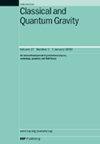Revisiting the apparent horizon finding problem with multigrid methods
IF 3.6
3区 物理与天体物理
Q2 ASTRONOMY & ASTROPHYSICS
引用次数: 0
Abstract
Apparent horizon plays an important role in numerical relativity as it provides a tool to characterize the existence and properties of black holes on three-dimensional spatial slices in 3+1 numerical spacetimes. Apparent horizon finders based on different techniques have been developed. In this paper, we revisit the apparent horizon finding problem in numerical relativity using multigrid-based algorithms. We formulate the nonlinear elliptic apparent horizon equation as a linear Poisson-type equation with a nonlinear source, and solve it using a multigrid algorithm with Gauss–Seidel line relaxation. A fourth order compact finite difference scheme in spherical coordinates is derived and employed to reduce the complexity of the line relaxation operator to a tri-diagonal matrix inversion. The multigrid-based apparent horizon finder developed in this work is capable of locating apparent horizons in generic spatial hypersurfaces without any symmetries. The finder is tested with both analytic data, such as Brill–Lindquist multiple black hole data, and numerical data, including off-centered Kerr–Schild data and dynamical inspiraling binary black hole data. The obtained results are compared with those generated by the current fastest finder AHFinderDirect (Thornburg 2003 Class. Quantum Grav.21 743), which is the default finder in the open source code Einstein Toolkit. Our finder performs comparatively in terms of accuracy, and starts to outperform AHFinderDirect at high angular resolutions ( ) in terms of speed. Our finder is also more flexible to initial guess, as opposed to the Newton’s method used in AHFinderDirect. This suggests that the multigrid algorithm provides an alternative option for studying apparent horizons, especially when high resolutions are needed.再论多网格法的视地平求问题
视界在数值相对论中起着重要的作用,它提供了一种表征3+1数值时空中三维空间切片上黑洞的存在和性质的工具。基于不同技术的视地平仪已经被开发出来。本文用基于多网格的算法重新讨论了数值相对论中的视视界寻找问题。将非线性椭圆视视界方程化为具有非线性源的线性泊松型方程,并采用高斯-塞德尔线松弛的多重网格算法求解。导出了球坐标下的四阶紧致有限差分格式,并利用该格式将线松弛算子的复杂度简化为三对角矩阵反演。本研究开发的基于多网格的视地平仪能够在一般空间超曲面上定位视地平,不存在任何对称性。通过分析数据(如Brill-Lindquist多重黑洞数据)和数值数据(包括偏心Kerr-Schild数据和动态激励双黑洞数据)对该探测器进行了测试。将获得的结果与当前最快的查找器AHFinderDirect (Thornburg 2003类)生成的结果进行比较。Quantum gravity .21 743),它是开源代码Einstein Toolkit中的默认查找器。我们的查找器在精度方面表现相对较好,并且在高角度分辨率()的速度方面开始优于AHFinderDirect。与AHFinderDirect中使用的Newton方法相反,我们的查找器在初始猜测方面也更加灵活。这表明,多网格算法为研究视界提供了另一种选择,特别是在需要高分辨率的情况下。
本文章由计算机程序翻译,如有差异,请以英文原文为准。
求助全文
约1分钟内获得全文
求助全文
来源期刊

Classical and Quantum Gravity
物理-天文与天体物理
CiteScore
7.00
自引率
8.60%
发文量
301
审稿时长
2-4 weeks
期刊介绍:
Classical and Quantum Gravity is an established journal for physicists, mathematicians and cosmologists in the fields of gravitation and the theory of spacetime. The journal is now the acknowledged world leader in classical relativity and all areas of quantum gravity.
 求助内容:
求助内容: 应助结果提醒方式:
应助结果提醒方式:


